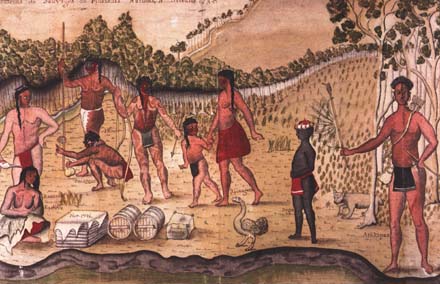
Drawing of Indians of several nations,(colored pen and ink by
Alexandre de Batz, 1735.)
The Bayogoula were a Native American tribe from Mississippi and Louisiana in the United States. Their name translates as "bayou people". They were a part of the Muskogean people. The Houma people attacked them around 1699–1700. They lived with another tribe, the Mougoulacha, in 1700. In the early 18th-century the Bayagoula killed many Mougoulacha, almost wiping out the entire tribe. This was triggered from a fight between the two tribes chiefs. The Tonica tribe moved into the community soon thereafter. In 1706 the Tonica ambushed the Bayagoula and almost killed all of them. By 1721, the rest of the tribe had suffered considerable deaths from smallpox. The remaining Bayogoula are believed to have moved to the area of the present day Ascension Parish of Louisiana, possibly melding into the community of the Houma and Acolapissa who lived there.*
Before European contact, the Bayougoula and Mugulasha were the only tribes that spoke a Choctaw dialect of the Muskogean language family that lived west of the Mississippi River. However, with the exception of their being from the "wrong side of the river," the Bayougoula were quite similar to their cousins on the opposite side. Since their tribal totem was the alligator (an animal unique to the lower Mississippi), they obviously had been there for a long time before their meeting with the French. They also exhibited many traits from the Mississippian culture which had dominated the entire region before 1540. Their housing was circular in shape and used the wattle-and-daub construction (thatched roof) typical of the area. At the time of their first meeting in 1699, the French noted that the Bayougoula were still building large earthen platform mounds on top of which they placed their important public buildings - the chief's house a large (30' diameter) temple for religious ceremonies. The temple also contained sacred objects and an eternal fire kept burning by the village priest.
The swampy nature of the area made burial undesirable, so the Bayougoula placed their dead on high platforms to protect them from animals during decomposition. Once this was complete, the bones were placed in a tribal ossuary (bone house).
Hunting, using fire to drive the animals into the open, was important with buffalo, turkey, deer, and alligator, and fish being the major prey. However, the bulk of the Bayougoula diet was provided by their agriculture: corn, bean, squash, melons, sunflowers, and tobacco. Fields were relatively small, but the long growing season of the region allowed them to harvest two to three crops from the same field. Dogs were the only animal domesticated by Native Americans before the horse, but the Bayougoula in 1699 kept small flocks of turkeys. The tribes of the lower Mississippi were also unique in that tribal territories were well defined. Decorated with fish heads and bear bones, a large red post near the mouth of the Red River marked the boundary between the Bayougoula and the Houma just to the north. Translated into French, the location of this "Red Post" became known as Baton Rouge, the present-day capital of Louisiana.*
CIB
Kin 16: Yellow Electric Warrior
I activate in order to question
Bonding fearlessness
I seal the output of intelligence
With the electric tone of service
I am guided by the power of universal fire.
Once the human mind is established in the 13-20 timing frequency, then the frequency locks open.*
*Star Traveler's 13 Moon Almanac of Synchronicity, Galactic Research Institute, Law of Time Press, Ashland, Oregon, 2016-2017.
The Sacred Tzolk'in
Muladhara Chakra (Seli Plasma)





No comments:
Post a Comment